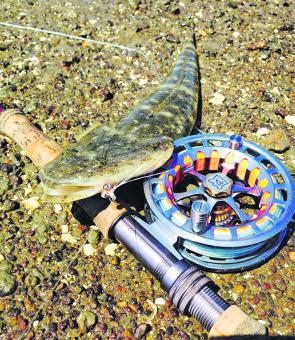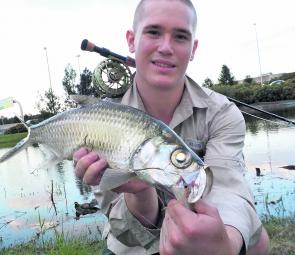Last month, we looked at getting into fly fishing, sorting out gear and zeroing in on some target species. This month, we’ll look at a few tips and tricks you can do with light fly tackle.
When most people start out fly fishing, they’ll usually gravitate toward the lighter end of the spectrum. For me, anything beyond 8wt tackle is heavy, and anything under that I consider light.
Starting small is a good idea for several reasons. The two main reason being, a) overall, it’s cheaper and b) the fishing is more accessible. Another good reason to start light comes from a saying in game fishing, ‘The bigger the bait, the bigger the stuff up’, and this is very true in the world of fly fishing! It might be best to learn the basics of fly fishing on light tackle before things get broken! Heavy tackle can be a bit crazy. More on that next month!
Setting up light rigs can be fairly simple or very complex, depending on what you wish to do with them. I like to keep everything simple as far as lines, leaders and flies go, but others like to wire out every fine detail – it’s a personal thing.
As a general rule, lines should match the task, so floaters should be used for surface work, intermediates for shallow sub-surface and fast-sinking lines for deeper fishing.
Backing isn’t usually an issue for light tackle and shouldn’t be stressed too much, unless you’re targeting small pelagics or other species that like to do some yards. On a small fly reel, around 100-150m of braided as backing should handle most situations, even if you hook into a small trevally or mackerel. Most species, particularly those in freshwater, will be easier fought by hand.
Leaders are fairly simple for me. If I’m casting generally I prefer to use a straight length of leader. If I’m casting toward structure or needing accuracy, I like to use a tapered leader (available from tackle shops) or one I make myself, using 2-3 different strength lines. The beauty of a tapered leader is that it will roll out neatly in a straight line, rather than just falling in a pile.
With homemade tapered leaders, the heavier material should be up the top, and the lighter material (tippet) should be what connects to the fly. A great guide to making tapered leaders is to have every length downwards about half the length of the one above. For example, at the top you may have 1m of 40lb monofilament, connected to about 50-60cm of 20lb fluorocarbon, then for a tippet, 30cm of 14lb fluorocarbon onto the fly.
Rods vary as much as the imagination these days, you can chose from a huge range of types from the lighter spectrum. Be sensible and match the your rod for what you will be doing primarily, but remember, fly rods are fairly versatile machines. I use my 6wt for bass, carp, flathead, trevally, tarpon, bream, sooties… the list goes on! There’s no need to buy multiple fly rods for fish that are all around the same size.
Roll casting is a skill that comes in handy when presented with tight surrounds. It’s a trick often employed when there isn’t room to facilitate a back cast. In other words, the trees behind you won’t let you cast across the pool in front of you.
The roll cast is fairly simple, and is commonly used by anglers chasing bass, trout, sooties and other smaller fish in tight water.
The roll cast starts when the angler is picking up the line for another cast, however, instead of lifting the fly out of the water, the angler allows a bow to form beside them by slowly raising the rod. Once there is a decent bow in the line and the rod is back at about 2 o’clock, snap the wrist sharply. The fly line should roll out and the fly should shoot out to the desired location. It’s possible to shoot a bit of line through the guides in a roll cast, too, if you require that extra distance!
Steeple casting is a useful technique for situations when there are obstructions behind you.
Much like a normal cast, the steeple cast has a front and back cast, however, in the back cast, the line is tossed up, to avoid the obstructions behind you. To do this, I often stop the rod in the back cast at about 12 o’clock and watch to make sure the line clears whatever I’m trying to avoid.
The roll and steeple casts tend to come in handy in the same areas.
This is very important for almost all types of fly fishing, with the exception of a few methods and species, such as trout, where the angler lifts the rod to strike. The term ‘trout striking’ is often used when a hook-up is missed due to the angler lifting the rod and pulling the fly out of the fish’s gob!
Strip striking is important for the simple reason that a fly rod and fly line doesn’t have a lot of stiffness. With conventional gear, setting a hook is simple – the stiffness of the braid and rod blank drives that hook point home. With a fly rod, the very slow action of the rod and stretch in the fly line is for casting light flies, not striking!
To strip strike, the rod is kept low. When a bite is transmitted though the line, the angler should strip to take up the slack, point the rod and the fish and allow the weight to load up for a second or two (it can be hard not to trout strike, I know!) This action sets the hook properly. If the rod is lifted, there’s barely any pressure going though the rod and line to the hook point, and in a lot of cases, the hook simply bounces of the fish’s jaw!
Remember, keep the rod down until you feel that tug of war with the fish through the line before lifting the rod!
Mending the line can be used for a few different applications. There’s to main applications. Firstly, to adjust fly line in water flowing at a different speed to the water the fly is in, which prevents it from dragging unnaturally (often used in trout streams). Secondly, to lay the line along side some good-looking structure, which will allow the fly to swim past it.
Mending the line starts once the cast has been made. When the current’s affect on the line, or surrounding structure has been assessed, flick the rod and make a ‘bump’ in the fly line. From here, the line you’ve picked up should be laid down where you want it. Throughout this, the fly remains where it is.
This technique can’t be performed with conventional gear, and I believe this gives a fly fisher an edge, particularly in the second situation.
As previously mentioned, the majority of fish are going to be fought by hand. The bendiness of the rod and stretch of the line makes up for the lack of a drag in the situation.
If you manage to lock horns with a fish with a bit more spirit than you anticipated, you can let some line go through your non-stripping hand as the fish lunges.
If the fish is very spirited (and probably too big for the tackle you’ve chosen), allowing the line to run through your hands and fighting the fish on the reel, and praying to the fishing gods that you have enough line, may be the only option.
If you fight them by hand and lock right up, particularly around tight country, you can really have an edge over anglers using conventional gear. If you strip a bass or sooty 2ft, you’ve pulled them 2ft away from their snag! Just remember, your tippet should be designed to break before the fly line – fly lines cost a fair bit, and you don’t want to damage them needlessly.
People also under estimate the authority you can have with a fly rod when fighting a fish. In most cases, the rod is around 8-9ft long – that’s a lot of length on your side for leading fish around and dominating them in the fight. If the fish goes one way, apply pressure in the same direction and fish will change direction accordingly.
That’s about it for the light stuff! Next month I’ll talk in depth about heavy fly tackle and saltwater fly fishing.
For now, I wish you the best and hope you can get the most out of your light fly tackle and prepare for the bigger stuff (if that’s where you wish to go with your fly fishing). You could also keep fishing light like I do, nothing wrong with that!
Reads: 1327
If you live up north, sooty grunter are a sure-fireway to put a bend in your light fly rig. A good mix of small surface and sub-surface flies should see you hooked up.

The author caught this nice bass roll casting across a small pool under a bridge. A back cast may have resulted in the hooking of a pipe instead of a healthy bass…

Up and down our coast, if you want to get into fly fishing than flathead are a fun, simple, but challenging enough way to hook up.

Tarpon are a species that need a solid strip strike due to their notoriously hard jaw. Once hooked, hard-mouthed species that jump shouldn’t be able to shake a fly out too easily.

Don’t be afraid to fish from a kayak. Kayaking is a great way to explore new waters with the fly, particularly for bass.

It pays to experiment with fly gear. You may even catch species that are considered rare catches on conventional gear, such as this beautiful eel-tail catfish caught by the author in a clear SEQ stream.




